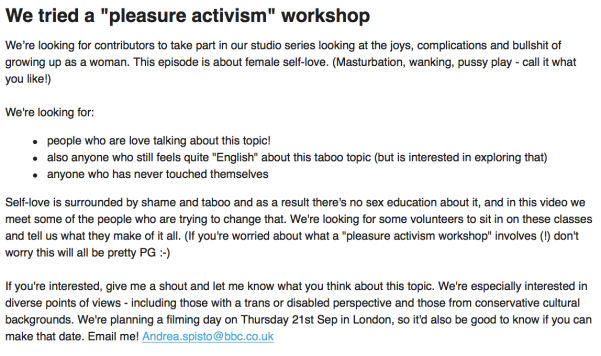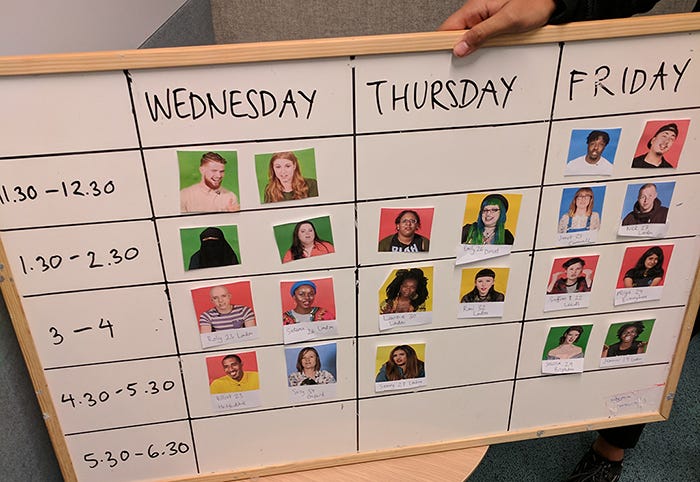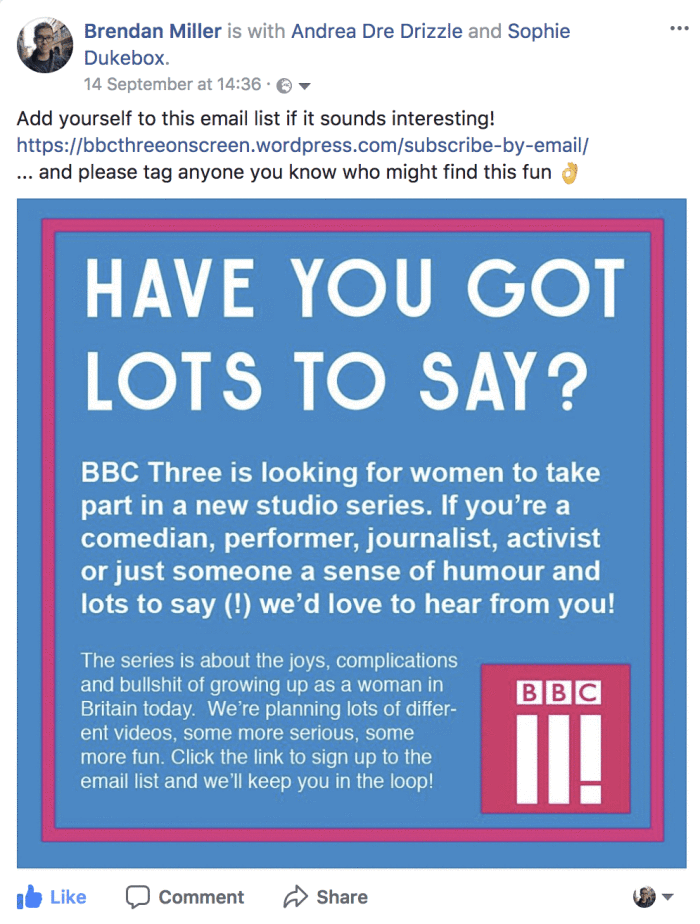
One line take-away: Don’t just interview the first people who say yes — spend time and effort to find stars.
For many documentary or video projects finding great contributors is critical.
It doesn’t matter how expensive your camera or how fancy your lenses, if the people you’re filming aren’t engaging the whole thing is a big waste of time.
But finding people with powerful experiences and who can speak engagingly, isn’t easy and that’s why I’ve created this guide. It’s aimed at anyone who’s trying to find ordinary, ‘real’ people to appear on camera.
The guide is designed to help you through the whole process from beginning to end, looking at questions like:
- How to get lots of people applying to take part in your project
- How to find people from a diverse range of backgrounds
- The best way to reject people who you’ve realised you don’t want to interview
Over the years I’ve made dozens of films based on the contributions of ordinary people (E.g. for the New York Times, the BBC) and — after making lots of mistakes — I’ve figured out a lot about what works and what doesn’t. Read this and you can save yourself the time and pain I went through!
1. Casting Brief
Before you start it’s really important to decide what it is you’re looking for.
Here’s some of the qualities I’m always looking for:
Larger than life
There’s a phrase sometimes used in TV: “The camera takes 30%.” It means that a performance on screen has 30% less energy, humour and vitality than real life. That’s why you want people who are larger than life — people who are funnier, more energetic, crazy than your average Joe.
“Normal” rarely cuts it.
Likeable
If you want your audience to hang out with a person or a group of people it really helps if the people you’re putting on are likeable. It’s a hard thing to define but it doesn’t mean attractive… It basically comes down to whether you want to spend time with them.
A mixture of humour and substance
I like to produce films that make people laugh and make people think and usually it’s different contributors bring more of one than the other. So I cast some people because they’re funny and bring energy and laughter; and others are there because of their knowledge, anger or outrage.
Influence?
A tick in people’s favour is if they have some kind of following on social media, which will help when it comes to publishing your film. On it’s own it’s not enough, but it is worth noting.
Do you mind if they’ve done other stuff?
Many people (often in news) want new “case-studies”. Personally, I’m less bothered but many casting producers will want “fresh” people.
A diverse cast
As filmmakers we’re always trying to cast diversely. This includes — but is not limited to — the following:
- Class / social background
- Race
- Gender (male, female, non-binary)
- Disability
- Region
- Mental health & neuro-diversity (e.g. autism)
- Body shape / beauty
- Sexuality
- Politics and point of view
Diversity depends on the topic
One thing worth noting is that diversity can depend a little bit on the topic. For example, a man is not normally considered an example of diversity but what if it was a film about sexually assault, where a significant minority of victims are men? What if you were making a film about nurses or primary school teachers, where most applicants are likely to be female but men are part of the workforce. You could find yourself seeking out male contributors to make your film more diverse!
“Relevant diversity” vs “Incidental diversity”
Sometimes a diverse cast is directly relevant to the subject matter. For example, I was recently casting a film for the New York Times in which we interviewed police officers from around the world about the death of George Floyd. With this topic, I felt it was essential to have black, male police officers amongst the contributors.
Incidental diversity is when someone’s ethnicity, gender or so on doesn’t appear to be directly relevant but it feels important to cast diversely anyway. For example, including a contributor with a disability in a film about being mixed race. (And often the attribute turns out to be very relevant to the topic in some way you didn’t expect!)
Only “A grade” contributors!
The main mistake people make with diversity is thinking it means taking “B grade” people. Too often I’ve heard producers say something like, “Well they’re not great but they tick a lot of boxes”. No.
The other gripe is, “they don’t apply”. But unfortunately that excuse doesn’t solve anything, you have to take action…. which leads us to:
2. Get lots of potentials
I realise the word “casting” is a bit controversial if you come from a journalism or documentary background. It maybe brings to mind the idea of acting and fakery when what we are after is truth.
But I use the word deliberately because it reminds us that we’re not just looking for volunteers.
This is the mistake I see a lot: people thinking that if your film needs three people you keep looking until you have three volunteers.
Wrong.
You need to talk to a lot of people (rule of thumb: three times the final target number) and then choose the best.
Just like directors audition actors and choose the best, that’s what we do with our contributors.
Not taking the time to do this is the single biggest reason this part of your film will suck.
Write your pitch
The first thing you need to think about is how are you going to pitch this to your target audience. What are the benefits of taking part? What are the objections or worries they might have? Think carefully about your wording.
I recommend starting a text document and titling it “useful text”. Once you have this honed (and if necessary approved by execs) you can repurpose this language into emails, ads and so on.
Another thing to think about is, “how hard a sell is this?”. The harder the sell the easier you more appealing you want it to sound, and the easier you want to make the application process.
Write your ad on Google Forms
For me, my first step is to take the language from the “useful text” document and write something up into a Google Form. (Google Forms are useful because applicants details go straight into a spreadsheet, whereas with email you have a lot of copy and pasting.) Here’s an example of me using a Google Form for a NYT film about elections.
And here’s another example, this time for a film about female masturbation (!). Like all the examples here, it’s not perfect but hopefully it’s a good example of a topic that’s not super-easy to cast.

General points:
- Don’t forget to include when you’re filming and where you’re filming.
- If there are previous examples of your work that can reassure applicants.
- It’s useful to know how old people are, what they do for a living, and to have a photo of them. Also if you ask them questions about the topic you’ll get an idea of how passionate they are. However if the group you’re after is harder to reach then you might try and make this first step as easy as possible.
Fees
Things Not To Say didn’t pay a fee. The reasons for this were 1) it has a small budget 2) these are interviews and we don’t want people to be tempted to exaggerate their experiences for money. If this is your situation the best approach is to be upfront about things but there can still be kick-back.
However on my more recent projects, I’ve usually offered a fee of between £50 and £150. I think this will be increasingly the norm in future.
Getting people to see the ad
Once I have my Google Form set-up I’m trying to get as many people to go there as possible. Here’s some basic things to try:
- Post on your own Facebook & Twitter and other social media accounts about the project
- Email everyone at work
- Websites like https://www.starnow.co.uk/ (though many find the people who apply not right – lots of actors, wannabes etc)
- Ask big employers to share ads on their company mail lists
- Search for television casting accounts on Twitter (Here are three examples for the UK)
- I’ve now started an email list for people interested in appearing in my video projects. Here’s the website to give you an idea if you want to try something similar
Casting posters
Another option is a casting poster for social media. I now use a customisable TinyURL to make it easier for people to go to the right place. Here’s a Photoshop template and below are some examples:
Look for influencers in the target community
This advice is from fellow filmmaker Rubina Pabani, who also produced Things Not To Say:
“Every online community has its leaders and these people are the access doors to more people. A person who has a big following in the community has already done the hard work of rallying the community to one place, whether it be on a blog, twitter account or YouTube channel these people will open the door to niche groups. I always ask for help and encourage them to be part of the editorial so that the films feel like collaborations between us and that community. When you find the door, open it and read the comments on articles, videos, Facebook threads and find those people.”
She describes how one contributor in her tattoos film ran an influential blog which both cast and promoted the film. Another time, she got help from a red-headed photographer had made a “Hot Gingers” calendar; March, April, May were all in the final film!
So think about:
- Charities
- Unions
- Journalists
- Campaigners
- Magazines
- …
Go outside
Are there physical locations where people hang out? We cast for people with HIV in sexual health clinics. For Free Speech audience producers put posters up in shops and other places, or ask people in the street.
Targeted casting
We’ve talked about general casting, but sometimes your film requires particular people. Some ways to do this:
- Look for articles — either first-person pieces about a topic or those where a journalist has interviewed others
- YouTube videos
- Twitter accounts
- Comedians who’ve talked about the topic
- Ask community leaders / ambassadors who they recommend talking to
Try not to outsource your casting
Sometimes charities or institutions will want to do the selection process for you. The reason is they want to protect their volunteers from having their time wasted. However try and resist this if possible — you want to make your own judgements.
3. Finalising your cast
Now you’ve got (hopefully) scores of applications, it’s time to whittle them down.
Is there video?
Watching someone on video (hopefully doing something similar to what you’re casting for) is the fastest way to assess someone. If that’s available go straight for that.
Phone calls
Talking to people on the phone or via Skype is one of the best ways to assess what people are like.
Also, if the person you’re talking to is good, this is a good chance to connect with them in a way that can be useful later. In the studio when the lights and camera are on them it’s useful if you can say, “When we spoke on the phone I remember you telling me ____”.
The situation you’re trying to avoid is speaking to someone for a long time who you know – usually quite quickly – is not going to be great. To avoid this, I usually tell people it’s only going to be a short research call about basic information, then I’ll keep adding more time on if they sound good (“Oh while I’ve got you here on the phone, can I ask you a bit about the subject…”)
Take notes
I use a spreadsheet and type notes right into one of the squares. It’s really useful for when you come to putting together your shooting plan.

Get one of those headset things
Once you’ve got neck cramp from using a normal telephone you won’t knock it anymore.
Don’t forget these basic questions:
- Are you free on the filming date? (Start with this! Don’t presume they read the ad)
- What do you do for a living?
- How old are you?
- Where are you based?
Give yourself wiggle room
Lots of people will think the fact you’re calling them on the phone means they’ve been selected to be in your film project. It’s important to let them know this isn’t the case to avoid awkward situations later. Say something like:
“Thank you for speaking to me. We’re really excited about this project. Before we start I just want you to know that we’re speaking to lots of people and if we don’t end up using you it’s not because you’re not good, it’s just because we’re trying to find the right balance of perspectives and backgrounds. Shall I start by telling you a bit more about the project?”
Get a photo
A photo really helps you get a sense of someone. It doesn’t mean picking the prettiest or handsome contributors, it’s just about trying to get a feel for someone.
Beware casting people you know
If you know someone it’s quite hard to know how good they are really. Ask someone else to do the research call. Also what if you (or your boss) ends up cutting them from the edit because they were rubbish? Casting friends is something I avoid.
Mental health topics
You should get proper advice (e.g. from BBC’s Editorial Policy or the charity Mind) on contributors with mental health issues talking about their experiences on camera. However one question to consider at the start is, have they spoken about their experience before publicly? Also you need to make sure you’re set up to make it really easy for people to pull out if they’re feeling unsure or unwell. You don’t want to be in a position where you’re tempted to bully someone into staying involved because you’re behind schedule or something
Make a wall chart

Pitching
In big productions, casting APs and researchers will be pitching contributors to producers and execs. This often involves editing videos from Skype calls, filming test videos and so on. Even if you’re not doing all this it’s important to pitch your first choices to someone else. It forces you to be clear about why you think someone should be in the film and what they’re bringing to it.
At this point you want A+ people only! No second-best. No weak candidates. No “not-quite-sure” people. You should be excited about these people.
None of these are reasons to cast someone:
- You had a long chat with them and you feel bad that you might have wasted their time
- You don’t want them to hate you
- You don’t want them to be disappointed
- They already believe (for some reason) that they’re coming
- They “tick boxes”
- There’s no harm in having extra options in the edit
Sooner is better
The sooner you drop someone who’s not A+ the better. You think it’s awkward now, wait until you’re filming with them and they’ve told all their friends about it and you don’t feature them in the edit because they’re a bit naff.
Here’s some language that might be helpful:
I’m very sorry about this but unfortunately we’re not currently able to use you for the filming on Thursday. I really enjoyed speaking to you on the phone but because we’re trying to get the right balance of experiences, my producer has opted to use other people this time. However, if you’re still interested I’d like to keep in touch in case something changes. [We also expect to do films on other topics in the coming weeks, if you’re still interested I can add you to an email list to let you know about topics as they come up.]
4. Record
How to organise your shoot day and how to get the best out of contributors is such a big topic, I’m going to post about it separately another time. For now please remember:
Expect drop-outs
Try and have a few people in your back pocket for when someone drops out, which WILL happen. This is one of the main reasons I filmed with 4 pairs of people on Things Not To Say, as with 3 pairs I can still cut a film, but with 2 it’s pretty impossible.
5. Aftercare & publishing
It’s good practice if you can send people a quick note after filming to say thank you. This is especially important if you’re doing anything about mental health.
Encourage people to share the film
If you’re targeting a community, the people in your film can really help seed it out once its published. This is a good chance to thank them. I say something like:
“Hello _____ ! So after a *lot* of editing — it was so hard to cut down all your great contributions down to just 4mins! — the film is finished: [links]
Obviously it’s so hard to cover everything about a topic in a short amount of time but we’re really excited about the final film and hope it can reach a big audience. If you’re about to share it on any social accounts or know any Facebook groups or email lists that might promote it, we’d be really grateful. (Pretty please!)
Thank you again so much for all your help!”
Remember your applications
One part of being a producer for online video is that marketing is now part of your job. You can’t just “post and hope”. So it’s a good idea to save all the applications you get so you can send them the video once it’s finished.
More resources
- How reality TV shows cast the right people – video from Vox


